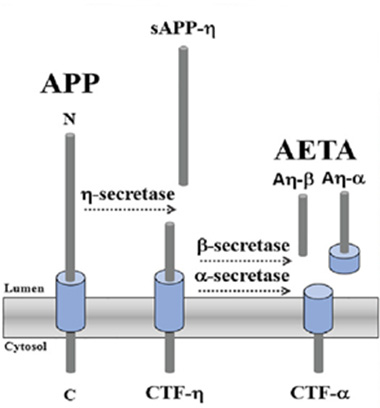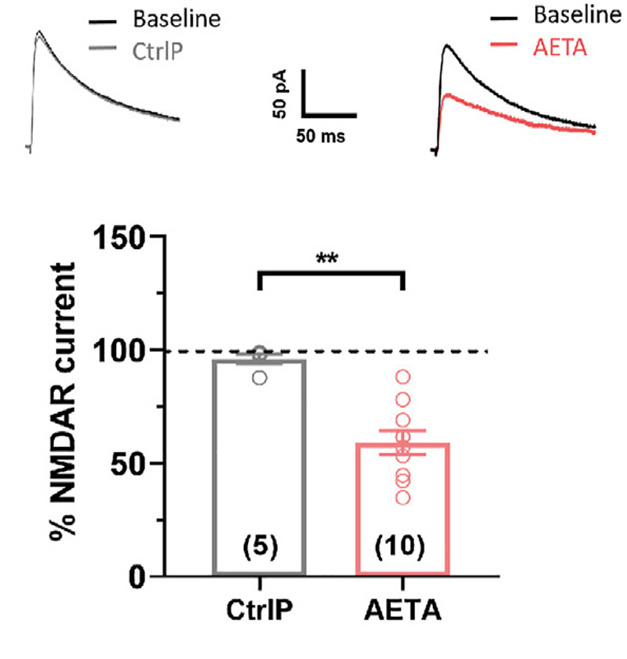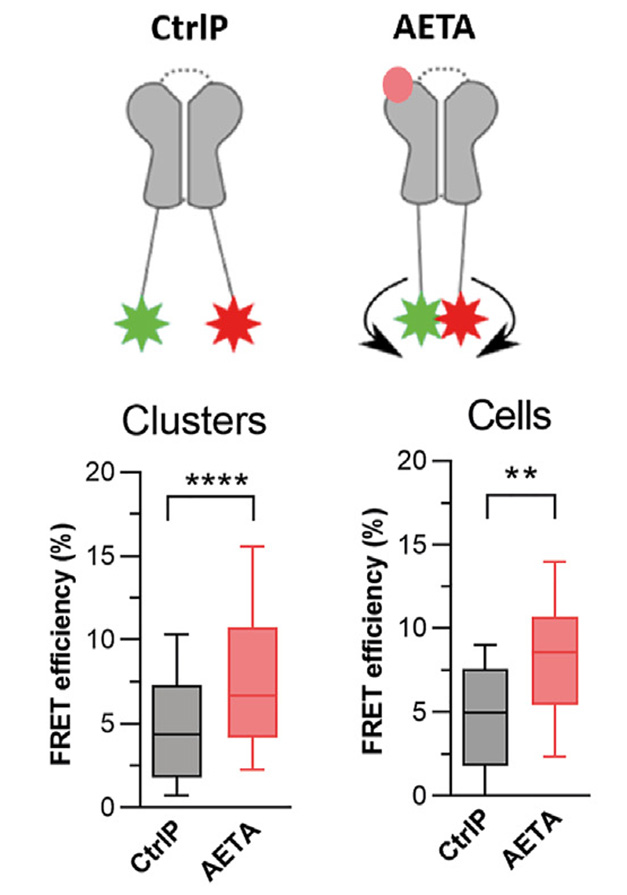Remember Amyloid-eta? A Decade Later, News on a Physiological Function
Quick Links
Aη, or A-eta, made an initial splash when scientists reported that these fragments of amyloid precursor protein—products of a heretofore unknown cleavage—dampen neural activity. But how? The story went quiet. Nine years later, comes a possible answer. In the June 14 Neuron, the same researchers, led by Hélène Marie, Institut de Pharmacologie Moléculaire et Cellulaire, Valbonne, France, and Michael Willem at Ludwig-Maximillians-Universität, Munich, report that the peptides modulate NMDA glutamate receptors.
- Aη peptides modulate NMDA receptors and neural activity.
- They weaken long-term potentiation and strengthen long-term depression.
- Mice need them for their memory to function properly.
Oddly, Aη both suppresses ion flux through these cell membrane channels and strengthens their non-ionotropic activity. No other modulator pulls off this dual action, according to the authors. In fact, no molecule has ever been found to activate the non-ionotropic signaling, they write. The upshot? Aη regulates synaptic plasticity by dialing down long-term potentiation and dialing up long-term depression. Willem now believes this might be one of APP’s main physiological functions.
“The work is both persuasive and believable,” Jesper Sjöström, McGill University, Montreal, told Alzforum. Sjöström studies NMDA receptor modulation and plasticity. He was surprised by these results, but thinks they make sense. “We were waiting to see this kind of pharmacology, something that would have differential action on the two modes of [NMDA] signaling,” he told Alzforum. “This makes us think about NMDA signaling and Alzheimer’s disease in different ways,” he noted.

To Better Modulate NMDA? Much like Aβ, Aη peptides get snipped out of APP by sequential proteolysis. A new paper proposes a function for the phenomenon. [Courtesy of Dunot et al., 2024.]
The sequential cleavage of APP’s ectodomain by η-secretase, followed by either α- or β-secretases, spawns Aη-α and the slightly shorter Aη-β (image above). Scientists have largely overlooked these products, focusing for decades on the infamous Aβ peptides that form amyloid plaques. In 2015, Willem, working in Christian Haass’ lab at LMU and collaborating with Marie’s group in Valbonne, reported that Aη peptides suppressed synaptic activity in the hippocampus (Aug 2015 news).
At the time, the finding did not catch on, in part, perhaps, because Willem had not yet figured out the mechanism. “It took 10 years,” he told Alzforum. “We needed the right techniques and the right models, and tour de force work by first authors Jade Dunot and Sebastien Moreno, but we’ve learned that these peptides modulate NMDA receptors in a way that might be important beyond AD, including for disorders such as schizophrenia and depression,” he said.
Dunot and Moreno, both in Valbonne, found that Aη suppresses synaptic activity by competing with the NMDA co-agonists glycine or D-serine. This throttles calcium entry through the channel—the ionotropic flux. In mouse brain slices, Aη reduced current through CA3-CA1 synapses of the hippocampus by about a third. Conductance through AMPA glutamate receptors was unaffected.

The Ionotropic Bit. Ten nM Aη suppressed NMDAR current in mouse hippocampal slices by 35 percent. [Courtesy of Dunot et al., 2024.]
NMDA activation can also lead to non-ionotropic signaling. This is often referred to as metabotropic signaling, but Marie prefers the former term in this case. “‘Metabotropic’ suggests G proteins are involved, and we don’t know if that is true,” she said.
Dunot and colleagues found that Aη caused a conformational change in the cytoplasmic domains of the NMDA receptors, which activated p38 inside the cells (image below). Previously, scientists in Karen Zito’s lab at the University of California, Davis, had discovered that this kinase mediates NMDAR-dependent shrinkage of synaptic spines, along with a weakening of synaptic strength. This resulted in long-term depression (LTD) of synaptic circuits (Stein et al., 2020). Zito collaborated with Willem and Marie on the current study.

The Non-Ionotropic Bit. Fluorescence resonance energy transfer (FRET) between cytoplasmic tails of NMDAR subunits (top) strengthens in the presence of Aη, suggesting a conformational change. This causes LTD. [Courtesy of Dunot et al., 2024.]
In keeping with the p38 induction, the scientists found that Aη promoted spine shrinkage and LTD in hippocampal slices. This happened even in the presence of the NMDAR ion channel blocker MK801, confirming that ion flux had nothing to do with this effect.
To check if this synaptic modulation can happen without adding exogenous Aη, Dunot and colleagues treated mice with the BACE inhibitor LY2811376. Blocking BACE gives η-secretase, which is as yet unidentified, a chance to cleave APP, since both secretases vie for the same substrate. Indeed, these mice had twice the normal levels of Aη peptides. In hippocampal slices from them, LTD was more pronounced even without added Aη. Bringing genetics to bear, the scientists found that knocking out the η-secretase cleavage site did the opposite. Post-synaptic currents in the hippocampus came at higher frequencies, and LTD could not be induced without adding Aη.
All told, the authors conclude that Aη’s modulation of NMDAR is a physiological phenomenon. Indeed, when they chemically activated neurons in the prefrontal cortices of mice, Aη levels there quadrupled. This suggests that not only do the peptides control synaptic activity, but the reverse is true as well.
Is all this relevant to function? This question is not fully explored, but mice lacking the η-secretase site in APP froze less often than did wild-type controls when threatened with a foot shock. This type of contextual fear memory is known to rely on NMDA receptors.
Could NMDA receptor modulation by Aη even be the raison d’être for APP? Willem thinks so. Despite APP’s established importance in Alzheimer’s development, understanding its main function has largely eluded the field. In their original 2015 paper the scientists reported that Aη accumulates over the course of the disease, possibly compromising NMDAR and synaptic spines and contributing to memory loss.
Since then, scientists led by Javier Sáez-Valero at Universidad Miguel Hernández, Alicante, Spain, reported that hC-terminal fragments of APP tick up in the CSF of people with sporadic and familial AD and in Down’s syndrome, suggesting elevated secretase processing (Garía-Ayllón et al., 2017). “To get a whole view of APP processing in AD would be challenging, because of the necessary inclusion in the equation of α- and β-secretase, and even γ-secretase activity,” Sáez-Valero and colleagues wrote to Alzforum. “Additionally, it is plausible that different APP fragments can modulate NMDAR in opposite ways, directly, or indirectly, by competing with each other, but also by blocking each other.”
Indeed, unknowns abound. For one: How do Aη peptides pull off this dual, ionotropic/non-ionotropic modulation of NMDA receptors? “That’s difficult to say,” Willem acknowledged. These 22kDa peptides are huge compared to the co-agonist single amino acids, raising steric questions. “They are obviously covering the co-agonist site, and we’d love to know if smaller peptides would be sufficient,” Willem added. He thinks a crystal structure might be necessary to figure this out.
There’s also some mystery surrounding the η-secretase(s) themselves. The matrix metalloprotease MT5-MMP cleaves at the η site on APP, but Willem said that other enzymes do, too. “Which of these might be physiologically regulated, or upregulated in AD, needs to be investigated,” he said. Synaptic activity boosts η-secretase processing, but Willem said he does not know how this happens. There could be more enzyme, more brought to the cell surface, or simply more activity because some inhibitor has been removed, he suggested. Previously, crossing MT5-MMP nulls with 5xFAD mice improved LTP, but curiously reduced amyloid levels as well (Baranger et al., 2016).
All told, Willem hopes these findings will rally interest around these Aη peptides. For her part, Marie thinks the new data may push the NMDA field in new directions. One major consideration for the AD field is the effect of BACE inhibition, which shifts the balance of APP peptides away from Aβ and toward Aη. Some think this might explain the cognitive decline seen in BACE inhibitor trials, which suppressed BACE by about 70 percent. “It will be enlightening to see if low-dose BACE inhibition, i.e., decreasing BACE1 by only 30 percent, as has been proposed for the revival of BACE inhibitors, has any deleterious effects on Aη-mediated LTD (and LTP) changes,” wrote Justyna Zakaria, Northwestern University, Chicago.—Tom Fagan
References
News Citations
Paper Citations
- Stein IS, Park DK, Flores JC, Jahncke JN, Zito K. Molecular Mechanisms of Non-ionotropic NMDA Receptor Signaling in Dendritic Spine Shrinkage. J Neurosci. 2020 May 6;40(19):3741-3750. Epub 2020 Apr 22 PubMed.
- García-Ayllón MS, Lopez-Font I, Boix CP, Fortea J, Sánchez-Valle R, Lleó A, Molinuevo JL, Zetterberg H, Blennow K, Sáez-Valero J. C-terminal fragments of the amyloid precursor protein in cerebrospinal fluid as potential biomarkers for Alzheimer disease. Sci Rep. 2017 May 30;7(1):2477. PubMed.
- Baranger K, Marchalant Y, Bonnet AE, Crouzin N, Carrete A, Paumier JM, Py NA, Bernard A, Bauer C, Charrat E, Moschke K, Seiki M, Vignes M, Lichtenthaler SF, Checler F, Khrestchatisky M, Rivera S. MT5-MMP is a new pro-amyloidogenic proteinase that promotes amyloid pathology and cognitive decline in a transgenic mouse model of Alzheimer's disease. Cell Mol Life Sci. 2016 Jan;73(1):217-36. Epub 2015 Jul 23 PubMed.
Further Reading
No Available Further Reading
Primary Papers
- Dunot J, Moreno S, Gandin C, Pousinha PA, Amici M, Dupuis J, Anisimova M, Winschel A, Uriot M, Petshow SJ, Mensch M, Bethus I, Giudici C, Hampel H, Wefers B, Wurst W, Naumann R, Ashby MC, Laube B, Zito K, Mellor JR, Groc L, Willem M, Marie H. APP fragment controls both ionotropic and non-ionotropic signaling of NMDA receptors. Neuron. 2024 Aug 21;112(16):2708-2720.e9. Epub 2024 Jun 14 PubMed.
Annotate
To make an annotation you must Login or Register.

Comments
Instituto de Neurociencias de Alicante
Instituto de Neurociencias, Universidad Miguel Hernandez
Universidad Miguel Hernandez
Several secretases are involved in the proteolytic processing of the amyloid precursor protein (APP) and, as a result, different proteolytic fragments are generated. How APP fragments interact and influence APP proteolytic processing merit profound research. In this interesting manuscript, Dunot and colleagues reported that AETA (Aη) fragments act as NMDAR modulators, and, conversely, that Aη generation depends on NMDAR activity. Previous studies indicated that APP and other APP fragments control NMDARs (see Pousinha et al., 2017; Rajão-Saraiva et al., 2023; Cousins et al., 2019; Hoe et al., 2009), including intracellular domain fragments via transcription-dependent mechanisms (Pousinha et al., 2017).
The employment of this complex machinery to generate APP fragments suggest that they play physiological roles. Thus, it is of interest to decipher whether activity of η-secretase is altered in AD, as previous data suggest. Anyhow, to get a whole view of APP processing in AD would be challenging, because of the necessary inclusion in the equation of the activity of α- and β-secretase, and even γ-secretase. Additionally, it is plausible that different APP fragments can modulate NMDAR in opposite ways, directly, or indirectly by competing each other, but also blocking each other.
Full-length APP (Cuchillo-Ibañez et al., 2015) and APP C-terminal fragments are present in CSF (García-Ayllón, et al., 2017), some probably resulting from proteolytic processing by η-secretase. It would be interesting to determine the presence of Aη fragments in AD CSF, and whether these fragments form heterogeneous complexes with other soluble APP species, as we have reported previously. At the interstitial space, secreted Aη fragment could form complexes with soluble APP fragments, and with the membrane resident APP peptides, affecting APP physiological function.
Dunot and colleagues claim that Aη enhances LTD via non-ionotropic activity of NMDARs because LTD still occurs after MK-801 (NMDARs blocker) treatment. There is evidence that while LTP is mainly driven by the activation of synaptic NMDARs ((Papouin et al., 2012). LTD requires the activation of both synaptic and extrasynaptic NMDARs (Liu et al., 2013). Given that MK-801 preferentially blocks synaptic over extrasynaptic NMDARs (McKay et al., 2013), it is also possible that the LTD exerted by Aη is driven by extrasynaptic NMDAR-mediated ionotropic activity. In the competition of Aη with NMDAR co-agonists to inhibit ionotropic activity, Dunot and colleagues use D-serine, the co-agonist of synaptic NMDARs; it will be of interest to study this with glycine, the co-agonist of extrasynaptic NMDARs (Papouin et al., 2012). Thus, the possibility that Aη modulates extrasynaptic NMDARs-mediated ionotropic activity should be studied.
References:
Pousinha PA, Mouska X, Raymond EF, Gwizdek C, Dhib G, Poupon G, Zaragosi LE, Giudici C, Bethus I, Pacary E, Willem M, Marie H. Physiological and pathophysiological control of synaptic GluN2B-NMDA receptors by the C-terminal domain of amyloid precursor protein. Elife. 2017 Jul 6;6 PubMed.
Rajão-Saraiva J, Dunot J, Ribera A, Temido-Ferreira M, Coelho JE, König S, Moreno S, Enguita FJ, Willem M, Kins S, Marie H, Lopes LV, Pousinha PA. Age-dependent NMDA receptor function is regulated by the amyloid precursor protein. Aging Cell. 2023 Mar;22(3):e13778. Epub 2023 Jan 26 PubMed.
Cousins SL, Hoey SE, Anne Stephenson F, Perkinton MS. Amyloid precursor protein 695 associates with assembled NR2A- and NR2B-containing NMDA receptors to result in the enhancement of their cell surface delivery. J Neurochem. 2009 Dec;111(6):1501-13. PubMed.
Hoe HS, Fu Z, Makarova A, Lee JY, Lu C, Feng L, Pajoohesh-Ganji A, Matsuoka Y, Hyman BT, Ehlers MD, Vicini S, Pak DT, Rebeck GW. The effects of amyloid precursor protein on postsynaptic composition and activity. J Biol Chem. 2009 Mar 27;284(13):8495-506. PubMed.
Cuchillo-Ibañez I, Lopez-Font I, Boix-Amorós A, Brinkmalm G, Blennow K, Molinuevo JL, Sáez-Valero J. Heteromers of amyloid precursor protein in cerebrospinal fluid. Mol Neurodegener. 2015 Jan 8;10:2. PubMed.
García-Ayllón MS, Lopez-Font I, Boix CP, Fortea J, Sánchez-Valle R, Lleó A, Molinuevo JL, Zetterberg H, Blennow K, Sáez-Valero J. C-terminal fragments of the amyloid precursor protein in cerebrospinal fluid as potential biomarkers for Alzheimer disease. Sci Rep. 2017 May 30;7(1):2477. PubMed.
Liu DD, Yang Q, Li ST. Activation of extrasynaptic NMDA receptors induces LTD in rat hippocampal CA1 neurons. Brain Res Bull. 2013 Apr;93:10-6. Epub 2012 Dec 25 PubMed.
Papouin T, Ladépêche L, Ruel J, Sacchi S, Labasque M, Hanini M, Groc L, Pollegioni L, Mothet JP, Oliet SH. Synaptic and extrasynaptic NMDA receptors are gated by different endogenous coagonists. Cell. 2012 Aug 3;150(3):633-46. PubMed.
McKay S, Bengtson CP, Bading H, Wyllie DJ, Hardingham GE. Recovery of NMDA receptor currents from MK-801 blockade is accelerated by Mg2+ and memantine under conditions of agonist exposure. Neuropharmacology. 2013 Nov;74:119-25. Epub 2013 Feb 10 PubMed.
Northwestern University, Feinberg School of Medicine
This report provides exciting new insights into the potential physiological role of a proteolytic cleavage fragment of amyloid precursor protein (APP), known as Aη (AETA), which was first discovered by the authors about a decade ago (Willem et al., 2015). APP is one of the most abundant proteins found in synaptic boutons. In sophisticated experiments, the authors show that Aη is a novel NMDA receptor regulator. It competes at the co-agonist binding site. Aη not only reduced NMDAR ionotropic activity but also promoted ion-flux independent activity. As such, long term depression (LTD) occurs at synapses and dendritic spines shrink.
Previously the authors demonstrated that both genetic and pharmacological inhibition of BACE1 activity results in a large increase in η-secretase cleavage products of APP, such as CTF-η and Aη-α. They also found that BACE1 inhibition resulted in a reduction of long-term potentiation (LTP) and that recombinant or synthetic Aη-α treatment lowered LTP ex vivo and in vivo. With the current report, BACE1 inhibition using LY2811376 increased endogenous Aη-α. BACE1 inhibition, at the tested dose of 100 mg/kg (LY2811376), did increase synaptic LTD with an associated twofold increase in Aη-α. This could be a contributing mechanism behind the reported cognitive worsening of past BACE1 inhibitor trial participants. It is important to note that the BACE1 inhibitor in this study is at an exceptionally high dose that was shown to decrease cortical Aβ in mice by nearly 70 percent (May et al., 2011). It will be enlightening to see if low-dose BACE inhibition, i.e. decreasing BACE1 by only 30 percent, as has been proposed in the revival of BACE inhibitors, has any deleterious effects on Aη-mediated LTD (and LTP) changes. At these lower doses, presumably such effects would be mitigated.
This report provides supporting evidence that implicates APP in the physiological function of NMDARs and a possible role in aging-related NMDAR changes as well as pathological changes in Alzheimer’s disease. Further studies are necessary to probe the possible pathophysiological role of Aη on NMDARs in these settings, as well as changes that might occur with low-dose BACE1 inhibition. Results of future studies will have important therapeutic implications.
References:
Willem M, Tahirovic S, Busche MA, Ovsepian SV, Chafai M, Kootar S, Hornburg D, Evans LD, Moore S, Daria A, Hampel H, Müller V, Giudici C, Nuscher B, Wenninger-Weinzierl A, Kremmer E, Heneka MT, Thal DR, Giedraitis V, Lannfelt L, Müller U, Livesey FJ, Meissner F, Herms J, Konnerth A, Marie H, Haass C. η-Secretase processing of APP inhibits neuronal activity in the hippocampus. Nature. 2015 Oct 15;526(7573):443-7. Epub 2015 Aug 31 PubMed.
May PC, Dean RA, Lowe SL, Martenyi F, Sheehan SM, Boggs LN, Monk SA, Mathes BM, Mergott DJ, Watson BM, Stout SL, Timm DE, Smith Labell E, Gonzales CR, Nakano M, Jhee SS, Yen M, Ereshefsky L, Lindstrom TD, Calligaro DO, Cocke PJ, Greg Hall D, Friedrich S, Citron M, Audia JE. Robust central reduction of amyloid-β in humans with an orally available, non-peptidic β-secretase inhibitor. J Neurosci. 2011 Nov 16;31(46):16507-16. PubMed.
Make a Comment
To make a comment you must login or register.